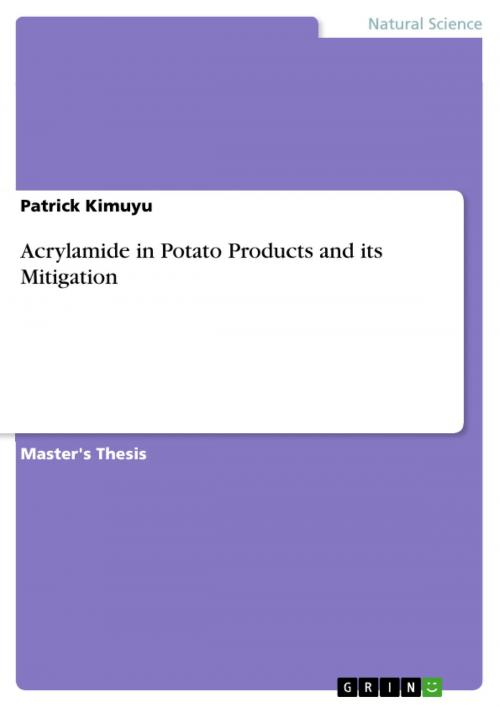Acrylamide in Potato Products and its Mitigation
Nonfiction, Science & Nature, Science, Biological Sciences, Physiology| Author: | Patrick Kimuyu | ISBN: | 9783668571921 |
| Publisher: | GRIN Verlag | Publication: | November 14, 2017 |
| Imprint: | GRIN Verlag | Language: | English |
| Author: | Patrick Kimuyu |
| ISBN: | 9783668571921 |
| Publisher: | GRIN Verlag |
| Publication: | November 14, 2017 |
| Imprint: | GRIN Verlag |
| Language: | English |
Master's Thesis from the year 2017 in the subject Biology - Diseases, Health, Nutrition, grade: 1, Egerton University (Public Health), language: English, abstract: Acrylamide has been found to be a biodegradable compound that exhibits high mobility in groundwater and soil. These characteristics are attributable to its physical and chemical characteristics including its high solubility in water and organic solvents such as ethanol and acetone. Clinical studies indicate that acrylamide forms glycidamide as the principal metabolite in animals. In humans, acrylamide and glycidamide are known to form adducts with most proteins including glutathione, and they are eliminated from the body through the renal system which serves as the primary route of acrylamide excretion. In the past decade, acrylamide has attracted immense attention from food agencies after it was found to be formed naturally in most carbohydrate-rich foods; thus, raising health concerns. The results obtained from epidemiological studies show that dietary acrylamide causes toxicity, and it is a potent carcinogen. Therefore, mitigation approaches have been designed including the reduction of acrylamide precursors in potatoes and controlling processing conditions.
Master's Thesis from the year 2017 in the subject Biology - Diseases, Health, Nutrition, grade: 1, Egerton University (Public Health), language: English, abstract: Acrylamide has been found to be a biodegradable compound that exhibits high mobility in groundwater and soil. These characteristics are attributable to its physical and chemical characteristics including its high solubility in water and organic solvents such as ethanol and acetone. Clinical studies indicate that acrylamide forms glycidamide as the principal metabolite in animals. In humans, acrylamide and glycidamide are known to form adducts with most proteins including glutathione, and they are eliminated from the body through the renal system which serves as the primary route of acrylamide excretion. In the past decade, acrylamide has attracted immense attention from food agencies after it was found to be formed naturally in most carbohydrate-rich foods; thus, raising health concerns. The results obtained from epidemiological studies show that dietary acrylamide causes toxicity, and it is a potent carcinogen. Therefore, mitigation approaches have been designed including the reduction of acrylamide precursors in potatoes and controlling processing conditions.















